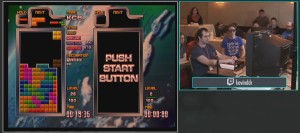
One of the global top players showcasing the insane reflexes needed to play the hardest modes of Tetris: The Grandmaster
Happy hot Wednesday, every reader! Well, it is for me here on yonder eastern coast of the US, but perhaps if you live in odd hemispheres of Earth then it is down right chilly. Oddness of living locations aside, it is globally time for something quite “awesome”. Twice a year there is a charity marathon event held by the people over at the old Speed Demos Archive website, which has been a source of speedrun game videos and record postings since ’98. I have perused the site from time to time, but the Summer Games Done Quick as well as the winter counterpart Awesome Games Done Quick are by far the highest profile things they have done. Since 2010 they have been raising money for various charities by streaming world record holders for specific speedruns playing through their games, often with donation incentives dictating how they accomplish their run or what they name their save file. Some world records have been set, and many nearly set, on camera but the main goal is to draw in donations by being entertaining as well as informative about the game being run and the type of speedrun being attempted. What ends up on display is a very positive energy, nonstop wave of gaming that lasts for an entire week.
Thanks to the exponential popularity of these marathons, with the first raising $10,000 in 2010 to the most recent raising over $1.5 million, speedruns have gained a lot of visibility as have their odd cousin Tool Assisted Speedruns (TAS) wherein a program is made to play the game as fast as the game software is capable. It happened more before, but I still see comments that seem disparaging of the idea of speedruns involving things like glitches or the TAS runs not being played by an actual human or the very idea of a speedrun looking more like work than the play “intended” by the developers. While people are more than welcome to dislike these things for whatever reasons they choose, I cannot be sure that it comes from a fully informed place. There are many different kinds of speedruns, many different goals and different rules or metrics being used to determine how records are set. If a glitch is used, for example, that sets the speedrun into a different category apart from runs that did not employ any glitches. Some of these glitches can be profound and cut otherwise a many hour long speedrun down to just minutes.
The different categories for speedrunning are what make the entire persuit so interesting and worth reexamining games over and over. “Any %” runs simply require the player to get to the end credits as fast as possible. “100%” runs obviously will require the player to acquire all optional collectibles, usually only those important to the plot or side-plot(s), before a finish time can be recorded. Glitched runs, while highly unorthodox, are usually the most bizarre and interesting to watch as players will find whatever exploits possible to skip areas, acquire items out of order, or manipulate the game code using only controller inputs. The most extreme cases can be seen in the TAS category, which is a personal favorite but also seems to draw the most criticism from casual and first-time observers.
TAS runs are not meant to showcase the same kind of skill that a normal speedrun is, but skill is indeed involved. At some level a TAS run is a lot like a normal speedrun as a player will record their inputs frame-by-frame, undoing any mistake possible, to generate the perfect run. Advantages of the continuous frame-perfect inputs are taken as players are able to do things much faster than the game software (or hardware) anticipates to open up a whole realm of possibilities. Finding these things takes a great deal of dedication, and some of it goes toward informing normal speedrunners of optimal routes. Among those extreme cases I mentioned before is a TAS program that was shown on-stream to reprogram a different game into the code of Super Mario World simply using frame-perfect button presses during gameplay. By the end of the demonstration, a simple replication of Snake was playing out using the assets of Mario World.
But above all, the stunning success of this charity event and the very interesting commentary on the games and types of runs being attempted on camera have proven good enough to raise millions of dollars for global charity efforts. And with fun things like two- or three-way speedrun races being live-streamed, two players using one controller, blindfolded (successful!) runs, and other demonstrations of world-class gaming talent, it is indisputable that this is a worthy form of entertainment for many people. It may not be for everyone, but it is doubtless for quite a few as this year’s marathon stream generally commands around 80,000 viewers at least and upwards of 150,000 during peak hours. I know I will be tuning in occasionally when I have time, as well as catching the uploaded videos of the games I missed. If you watch or intend to watch the event, let me know below! Have any favorite memories from this or past marathons? Speak up!
